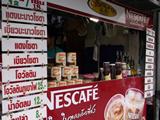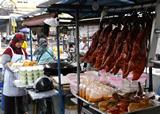- Home
- Floating Markets
Amphawa Floating Market
The Amphawa floating market is located about 90 km to the West of Bangkok just off the main highway that continues on to the popular holiday destination of Hua Hin.
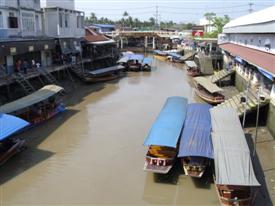
But before we head there, let's cover the basics of floating markets, to explain how they evolved.
Experience the Unique Culture of Bangkok's Floating Markets
Floating markets have a long history in Bangkok, with the network of canals having been around since the 18th century.
During the reign of King Rama I, the city’s canals were used to transport goods and supplies, but as the city grew, so did the need for a more efficient way to transport goods.
This led to the creation of floating markets.
Bangkok merchants would tie their boats together and set up shop, selling their goods and services directly from a small boat.
This tradition of floating markets has been passed down through the generations.
Floating markets are a great place to experience the culture of Thailand.
Popular with both local and international tourists, shopping is one of the main attractions of a floating market and visitors can purchase almost anything, ranging from souvenirs to fresh fruits and vegetables.
There are also stalls selling clothes, jewelry, and other intriguing items for the astute buyer.
Many vendors offer unique local products and bargaining
is encouraged.
Additionally there are restaurants and cafés along the canal where visitors can sample Thai cuisine and even small homestay residences available for overnight accommodation.
As well as sampling a variety of Thai foods, sightseeing is also popular around several Bangkok floating markets.
Visitors can take a boat ride to explore the canals and see the traditional wooden houses that line the banks.
Or take a guided tour of the market and learn about the history and culture of the area.
In the evening enjoy a boatride along the canals to see the fireflies and traditional palm sugar making.
Today, these markets are a popular tourist attraction, offering a unique opportunity to experience a traditional part of Thai culture from days gone by and where visitors can immerse themselves in the vibrant atmosphere.
There is ample opportunity to sample local cuisine and interact with the vendors and you even get a chance to practice your Thai speaking skills, as you bargain on your latest find.
Nearby Attractions
Don't forget to explore the nearby attractions. Visit temples and
shrines and experience traditional Thai culture.
Be sure to take your camera to capture great memories.
Traditional Floating Markets
Take an organised tour, or more adventurous travellers can make their own way to explore these markets.
- Amphawa Floating Market
- Tha Kha Floating Market
- Bang Nam Phueng Floating Market
- Khlong Lat Mayom Floating Market
- Damnoen Saduak Floating Market
- Kwan-Riam Floating Market
Floating Market Opening Hours
- Amphawa Floating Market - Open Friday, Saturday, and Sunday from 3:00 PM to 9:00 PM
- Tha Kha Floating Market - Open Saturday and Sunday from 8:00 AM to 5:00 PM
- Damnoen Saduak Floating Market - Open daily from 7:00 AM to 5:00 PM
- Bang Nam Phueng Floating Market - Open Saturday, Sunday, and public holidays from 8:00 AM to 4:00 PM
- Khlong Lat Mayom Floating Market - Open Saturday, Sunday, and public holidays from 8:00 AM to 5:00 PM
- Kwan-Riam Floating Market - Open Saturday, Sunday, and public holidays from 7:00 AM to 5:00 PM
Guided Tours
Book an organised tour with GetYourGuide. Click through to
see the various choices.
Complete the details below to check on availability and pricing.
Trip to Amphawa Floating Market
Amphawa is a great place to go and stay overnight as the area is rich in local history with many temples and attractions.
If you feel like driving yourself then it is very easy to do as the route is not too complicated.
If you are not that confident or sure of how to get to the Amphawa floating market then take a Thai driver.
Bangkok floating markets are a popular tourist attraction drawing many thousands of visitors each year and this lifestyle is unique to those communities that live on the water.

If you have never been to visit a floating market then it is one of those places that you have to visit at least once when you come to Bangkok.
The most well known Bangkok floating market is Damnoen Saduak which is actually not too far away from the little town of Amphawa itself.
When tourists request to visit a Bangkok floating market then this is the place that most Western tourists are taken to on the organised tours.
But the attraction of taking a tour of the Amphawa floating market is its popularity with Thai tourists, consequently you will not find many Westerners there.
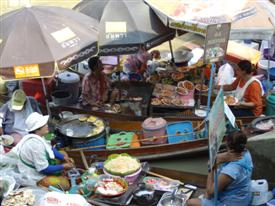
Not being so popular with Western tourists does give it more of an authentic feel, as you wander around through the the array of stalls and walkways of the Amphawa market and imagine a time gone by.
This floating market is held on Friday, Saturday and Sunday and vendors start setting up at around noon.
A good time to arrive is 3:30 pm to 4:00 pm when the heat of the day is starting to become bearable and the stalls are in various stages of being set up.
Go to Amphawa Floating Market
Leaving Bangkok around 11:00 am and taking the Dao Khanong exit on the expressway we proceeded along Highway 35 out of Bangkok on a straight road for about an hour, until we took the ramp to National Hwy No.325 / Route 3093.
After a few more kilometres and another left turn into a small soi, we arrived at a traditional Amphawa home stay cottage called Baan Imoun and checked in.
(We actually made the journey on a one page printout of a Google map, that is how straightforward the trip to Amphawa was).
Amphawa Homestay Cottage
Our booking had been made on the internet via the Agoda website a couple of days before.
We weren't really sure what to expect although it had good reviews from previous guests.
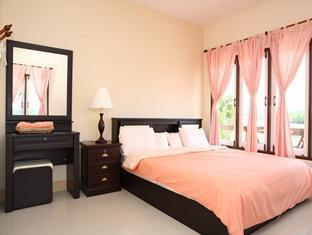

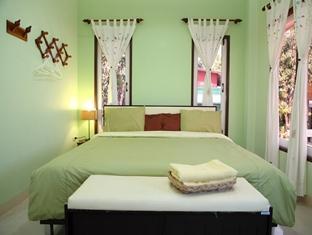
The room was clean and basic and at around 1400 baht, with breakfast, had everything needed for an overnight stay or even a few days.
As we had a guest with us there was an extra 200 baht to pay, but the room was already set up with another single bed so that worked out well.
Baan Imoun is typical of the type of Amphawa home stay places in this area.
The homestay has little cottages located on the banks of the Mae Klong river with sweeping views of the waterway from both the indoor dining and outside seating areas.
There were a number of rooms in the complex, some had small patios and views up and down the river and a couple of others set back a bit with what is often referred to in guide books as a "garden view".
There is also a small kitchen and shop on site.
Check out the special rates on Baan Imoun at the Agoda website.
It is an ideal location to go and explore the Amphawa floating market and local temples, as there are many Buddhist Temples in this area.
Organised Amphawa Tour from Bangkok
Explore Amphawa and surrounding areas as part of an organised day trip on a group tour from GetYourGuide.
Complete the details below to check on availability and pricing.
Exploring Amphawa
After leaving the bags in the room we went down to the outside seating area and ordered some lunch and took a moment to relax and take in the riverside views.
Shortly afterwards we set off in the car to explore the small sois in the immediate area and visit any temples that we happened to come across.
We didn't have any plan of where we needed to go and we couldn't understand the map that we were given as we checked in, as it was not to scale.
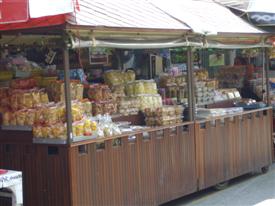
Whilst the map showed the general location of the Amphawa floating market, it did not show how to get there.
To top it off, in the haste of checking in, somehow I had managed to lose the Googlemap so we really had no idea of the way to the Amphawa market.
As luck would have it, after we had driven aimlessly around the nearby sois and visited a couple of local temples we ended up in the grounds of another temple that was located directly across the river from the Amphawa floating markets.
To be honest that was extremely good luck.
Anyway we parked the car in the temple grounds and took the small ferry for 3 baht each over to the other side.
The ferry runs until 11:00 pm so that gave us plenty of time to wander around the Amphawa floating market and not worry about the car getting locked in the temple grounds or anything like that.
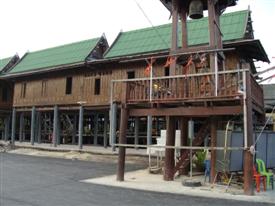
After disembarking from the ferry you will pass through a street market with food stalls, clothes and the usual nick nacks that are on sale in markets all over Thailand.
Follow the main street that goes to the khlong and then over a footbridge where you can see all the little boats selling their foods and fruits down below.
We spent all afternoon wandering around the shops and stalls along the side of the khlong buying bits and pieces of snacks for those back in Bangkok who were not fortunate enough to be able to come and visit the Amphawa Floating Market with us.
After sitting down and eating some seafood on the steps near to the bridge we walked all the way to the end of the markets, where we found a large temple.
There was nothing really stunning about the temple but the monk's accommodation was in the traditional Thai timber and style and was quite interesting.
Young boys in Monks robes sat about the structure or were playing together. Other children were playing on skateboards and the combination of the old and the new was fascinating.
We set off walking back and as it got towards 6:00 pm some of the bars alongside the khlong had started to open with live bands playing.
By then it was time for a beer and another sit down to take in more of the atmosphere as the Amphawa floating market came to life all over again.
Amphawa Firefly Tour
After a having a short rest, it was then about 7:00 pm and had started to become dark.
On the walk back to the little bridge in the middle of the Amphawa floating markets we stopped and booked to go on the Firefly tour; it was 60 baht each.
The Amphawa firefly tour is a very popular attraction amongst tourists and there were many boats offering trips to go and view the fireflies.
The long-tailed boat was only half full when the boat captain set off and took us over the river and down one of the little side khlongs on the other side.
Along this khlong you can see many of the other Amphawa home-stay properties in the area, along with private houses, that really gives you an insight into everyday life in Thailand.
The boat meandered its way along the khlong avoiding floating palm logs in the water and skirting the fish traps set up by local fishermen.
At one point we stopped because something had wrapped around the propeller shaft and the boat captain had to jump in the water to free it before we could proceed.
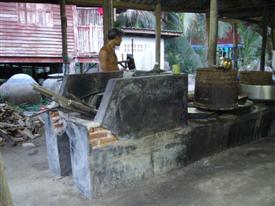
Finally we pulled up at a jetty and all passengers disembarked to spend a short time waiting until it became dark enough to be able to see the fireflies.
Interestingly enough we stopped at a site where they make palm sugar.
We were able to watch how they stoke the fire and heat the open pans to boil off the excess water to concentrate the sugar syrup and then ultimately pour the palm sugar into simple moulds.
You could buy the solid sugar if you wanted or there was some sugary type drink that seemed popular with the Thais.
Best of all the whole operation was not really commercialised and gave a good insight into how palm sugar is refined without the feeling of being ripped off.
It was pretty laid back. Nearly all of the other people were Thais and it was really targeting the local tourist market.
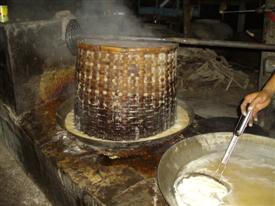
After 30 minutes or so of looking at the fire and boiling cauldrons filled with syrup we knew all there was to know about palm sugar and got back into the boat.
By now it was quite dark and we all had our eyes peeled looking for the elusive fireflies.
For those of you have followed my travels you will know that a previous excursion to see fireflies in Koh Chang had ended in disappointment as we saw one tree with one firefly. (Well perhaps more than one firefly, but not many more).
There again, when you go out to see natural phenomena it can never be guaranteed that you are going to see anything and on this night nature put on a big display for us.
During the return journey there were many trees hosting the small fireflies and even some glowing insects that were bobbing across the water.
Just like in a fireworks display, there were lots of oohs and aaahs from the boat as we spotted another tree adorned with these amazing little insects.
The fireflies were clustered in a particular species of tree and the boat captain sped along the khlong until we reached the next cluster and then went slowly past to give us all a chance to look.
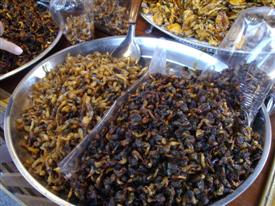
As we reached the end of the khlong we sensed it had all come to an end and once more we crosed over the Mae Klong river to return to the Amphawa floating markets.
By now it was about 9:00 pm and we set off walking back to the car.
Interestingly the street markets had really come alive by this time and there were many more people around and all of the stalls were now set up and manned selling all sorts of local foods and flowers.
We picked up three bottles of a local wine cooler to drink back at Baan Imoun, it turned out to be similar to Spy brand but much sweeter.
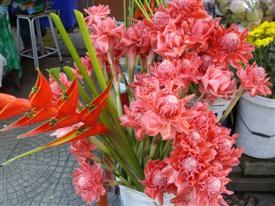
At the dock the ferry was waiting and he quickly sped across the river to the temple on the other side leaving the Amphawa floating markets behind us.
On arrival I dutifully paid the 9 baht to the attendant.
Back at Baan Imoun we finished off the day with a splendid meal and sat outside for a while drinking the local wine cooler and contemplated the day's events before turning in for the night.
What better way to end a perfect day than eating some Thai food on the banks of the Mae Klong river in Amphawa.
Amphawa Floating Market - Day 2
On wakening on the following Saturday morning and looking out of the window I spotted a 2 metre monitor lizard in the garden next door.
The big lizard had just climbed out of the Mae Klong river and was making its way across the river bank.

Before I could get my camera out of the bag it had disappeared out of view behind the fence.
These creatures inhabit waterways, are native to Thailand and can give a nasty bite, so stay well away if you come across one.
Breakfast was Thai style with a glass of orange coloured hot tea. It was the most vivid orange I have seen but it tasted okay.
Perhaps they have Western breakfast as an option, in my case I just ate what was put in front of me.
After packing up and paying for our meals we set off for Bangkok.
The plan was first to visit a temple that we had seen when we arrived and then to go to the Mae Klong markets.
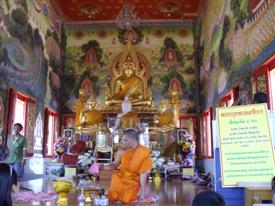
The interesting thing about the Mae Klong markets is that they are built over the train line and when the train comes through twice a day the vendors have to remove their goods and the awnings are pulled back to let the train through.
After driving just a few kilometres down the road we parked the car in the temple in the middle of Mae Klong town and then just walked over to the markets and spent some time walking through and looking at the live fish and fruits for sale.
Unfortunately the train did not pass through when we were there and as it was very hot we headed back to the car and set off for Bangkok.
Once we reached the main road we turned left towards Bangkok.
If we had of wanted to go from Amphawa to Hua Hin then we would have taken the flyover and turned right.
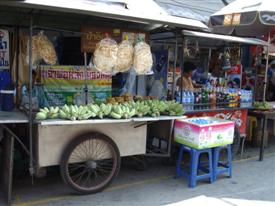
Travelling out of Bangkok is not difficult and most places are well signposted.
We all enjoyed our tour to the Amphawa floating market and would recommend Baan Imoun as a nice little homestay place.
If you don't have your own transport then the Agoda website has many Amphawa homestay choices right in the middle of town, alongside the khlongs, where you could stay and be right in the middle of the action.
If you are planning a Bangkok vacation then think about taking a tour of the Amphawa floating market, I feel sure you will enjoy the experience.
Damnoen Saduak Floating Market Tour
There are regular tours to the floating markets outside of Bangkok and this tour from GetYourGuide to Damnoen Saduak Market and the Maeklong Railway Market is popular amongst Bangkok Visitors.
Complete the information below to find more details of pricing and availability.
People also ask:
What days and times is Amphawa Markets open?
What days and times is Amphawa Markets open?
Amphawa Floating Market is open Friday, Saturday, and Sunday from 3:00 PM to 9:00 PM
Generally though it is best to arrive from 16:00 onwards, once the market stalls have set up and the sun is not so hot. You will then be able to stay until it closes and still have time for the firefly boat ride.
What are the main attractions and activities at the Amphawa Floating Markets?
What are the main attractions and activities at the Amphawa Floating Markets?
The main activities and attractions at the Amphawa Floating Markets are:
- eating traditional Thai seafood whilst overlooking the boats
- taking the boat tour along the river to see the fireflies and syrup preparation
- shopping for local products and souvenirs
- exploring the local homestay options and restored houses
Start to Plan Your Bangkok Trip Now!
- Read our Bangkok Travel Diary for more Bangkok must-see attractions and helpful tips.
- Explore a range of Things To Do In Bangkok - there are loads of activities and tours you can quickly book online or simply use as inspiration for your upcoming Bangkok travel.
- Don't forget to bring any of the essentials with our complete Packing List For Bangkok.
- Explore a range of Things to do in Ayutthaya - there are loads of activities and tours you can quickly book online or simply use as inspiration for your upcoming Bangkok travel.
- Need inspiration? Check our Bangkok travel books for ideas of where to go and what to do.
- Book a 3-hour Suvarnabhumi Airport lounge package. Relax in comfort prior to departure or for those longer transits via BKK Airport.
- Book a Bangkok airport transfer to take you direct from the airport to your hotel with the driver meeting you in Arrivals.
- Find available Bangkok hotels on Agoda - best rates and free cancellations.
- When is the cheapest period to travel to Bangkok with Google Flights - one search will show you the prices and times from scores of airlines for your trip.
- Learn more side income ideas to help pay for your travels
Revised 3-Aug-2024
Earn Money in Retirement with SoloBuildIt!
Imagine working from anywhere, on your own terms, and generating income during retirement, doing what you love. SoloBuildIt makes this dream a reality, empowering you to:
- Create stunning websites: No coding required! Drag-and-drop your way to a professional website that showcases your skills and offerings.
- Sell anything online: Easily set up an online store to sell products, services, or even digital downloads.
- Attract new clients: Powerful marketing tools help you reach your target audience and convert visitors into paying customers.
- Work from anywhere: Manage your website and business from any device, with complete flexibility and freedom.
SoloBuildIt is more than just a website builder:
- All-in-one solution: Everything you need to succeed online is included, from website creation to marketing and sales tools.
- Step-by-step guidance: Learn at your own pace with comprehensive tutorials, webinars, and expert support.
- Thriving community: Connect with other SoloBuildIt users and gain valuable insights and inspiration.
Stop dreaming, start doing!
Take control of your future and start building your online retirement income stream today. Try SoloBuildIt and experience the power of having your own website.
Click here to start your trial and unlock your earning potential!
Affiliate Declaration: I am a SoloBuildit affiliate and can earn commissions from sales of this product. This income helps me produce content for this site.
